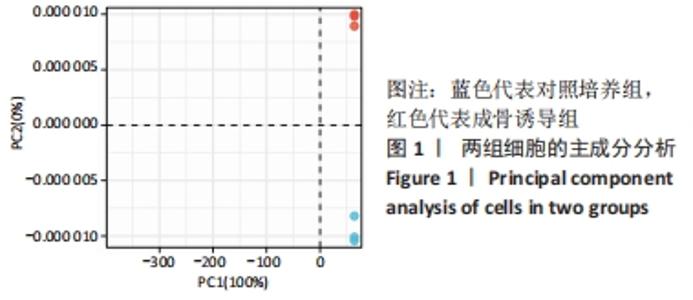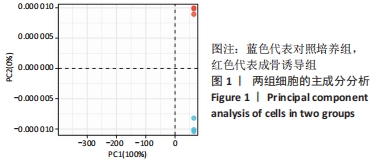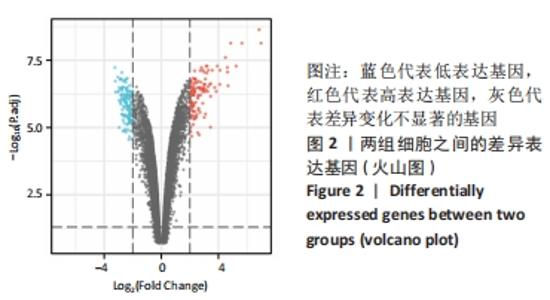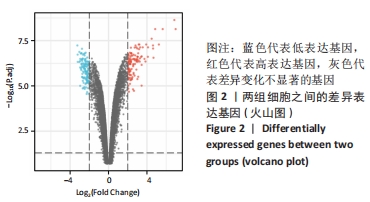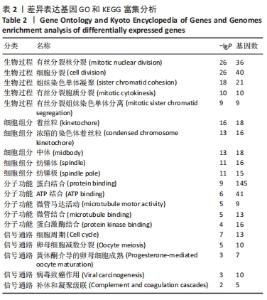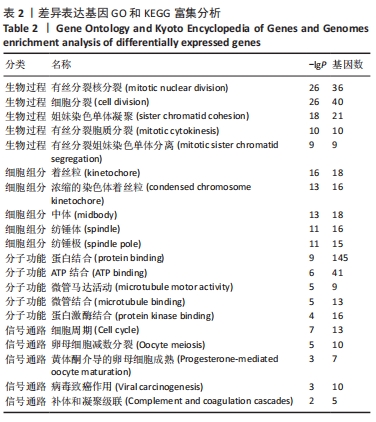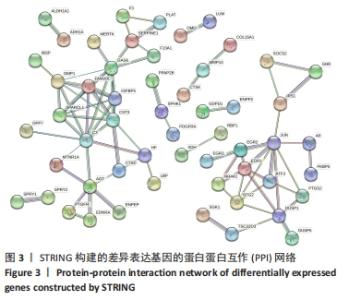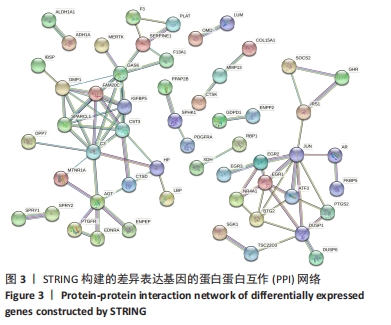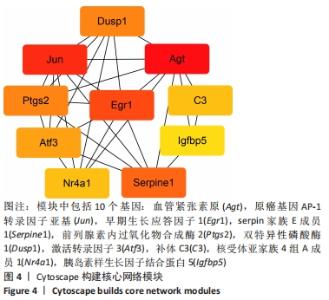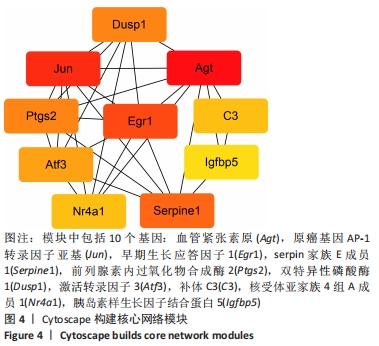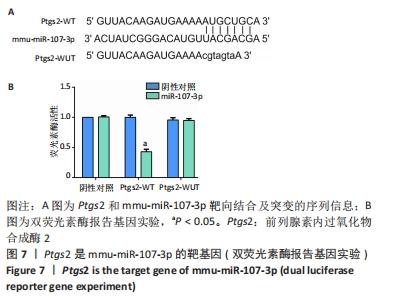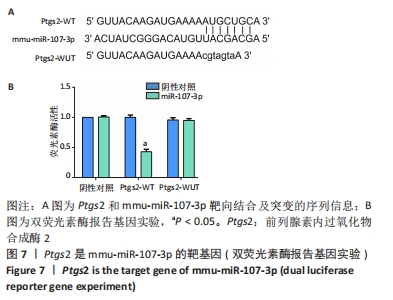Chinese Journal of Tissue Engineering Research ›› 2022, Vol. 26 ›› Issue (12): 1888-1893.doi: 10.12307/2022.512
Previous Articles Next Articles
Inhibition of the proliferation and osteogenic differentiation of MC3T3-E1 cells by targeting prostaglandin-endoperoxide synthase 2
Luo Mingran1, Fan Wenhao1, Li Xin1, Zhou Peng1, Wu Zerui1, Yuan Feng2
- 1First Clinical Medical College of Xuzhou Medical University, Xuzhou 221006, Jiangsu Province, China; 2Department of Orthopedics, Affiliated Hospital of Xuzhou Medical University, Xuzhou 221006, Jiangsu Province, China
-
Received:2021-07-30Revised:2021-08-02Accepted:2021-08-13Online:2022-04-28Published:2021-12-14 -
Contact:Yuan Feng, Professor, MD, Department of Orthopedics, Affiliated Hospital of Xuzhou Medical University, Xuzhou 221006, Jiangsu Province, China -
About author:Luo Mingran, Master candidate, Physician, First Clinical Medical College of Xuzhou Medical University, Xuzhou 221006, Jiangsu Province, China -
Supported by:Social Development Project of Science and Technology Department of Jiangsu Province, No. BE2016647 (to YF); Scientific Research Project of Jiangsu Provincial Health and Family Planning Commission, No. H201630 (to YF); Postgraduate Research and Practice Innovation Program of Jiangsu Province, No. KYCX21_2679 (to LMR)
CLC Number:
Cite this article
Luo Mingran, Fan Wenhao, Li Xin, Zhou Peng, Wu Zerui, Yuan Feng. Inhibition of the proliferation and osteogenic differentiation of MC3T3-E1 cells by targeting prostaglandin-endoperoxide synthase 2[J]. Chinese Journal of Tissue Engineering Research, 2022, 26(12): 1888-1893.
share this article
Add to citation manager EndNote|Reference Manager|ProCite|BibTeX|RefWorks
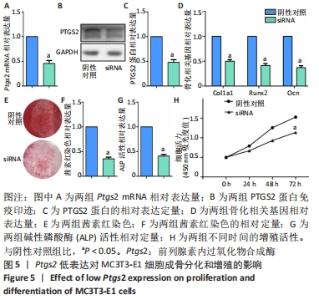
2.4 鉴定关键基因及靶miRNA Ptgs2是PPI网络核心模块中唯一参与骨矿化这一生物学过程的基因,即为鉴定得到的关键基因。选择Target Scan数据库预测到的miRNA作为Ptgs2的靶miRNA,包括 mmu-miR-26b-5p,mmu-miR-143-3p mmu-miR-101a-3p,mmu-miR-101b-3p,mmu-miR-107-3p, mmu-miR-103-3p,mmu-miR-144-3p。其中部分miRNA已有研究报道,选择尚无相关研究的mmu-miR-107-3p进一步验证其功能。 2.5 敲减Ptgs2对MC3T3-E1细胞成骨分化和增殖的影响 在MC3T3-E1细胞中转染Ptgs2-siRNA,3 d后提取mRNA,荧光定量PCR检测实验组的Ptgs2及骨化相关表达明显降低(P < 0.05),3 d后提取蛋白Western Blot结果显示实验组PTGS2蛋白明显降低(P < 0.05),碱性磷酸酶定量检测和茜素红染色及定量实验组较阴性对照组也明显降低(P < 0.05)。增殖实验中实验组的增殖活性明显降低(P < 0.05)。结果提示敲减Ptgs2基因后可明显抑制细胞的成骨分化和增殖活性,见图5。"
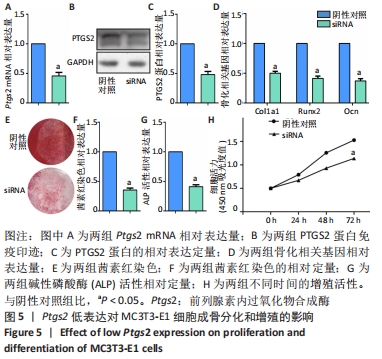
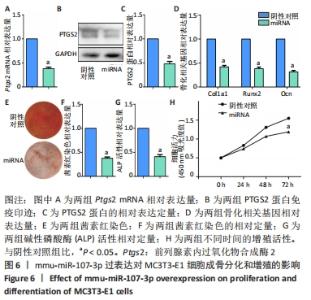
2.6 过表达mmu-miR-107-3p对MC3T3-E1细胞成骨分化的影响 在成功验证Ptgs2对成骨分化的影响基础上,进一步探索上游miRNA对Ptgs2和成骨分化的影响。在MC3T3-E1细胞中过表达mmu-miR-107-3p,3 d后提取mRNA,荧光定量PCR检测实验组的Ptgs2和骨化相关基因表达明显降低(P < 0.05), 3 d后提取蛋白Western Blot结果显示实验组PTGS2蛋白明显降低(P < 0.05),碱性磷酸酶定量检测和茜素红染色及定量实验组较对照组也明显降低(P < 0.05)。增殖实验中实验组的增殖活性明显降低(P < 0.05)。结果提示过表达mmu-miR-107-3p后可明显抑制细胞的成骨分化和增殖活性,见图6。"
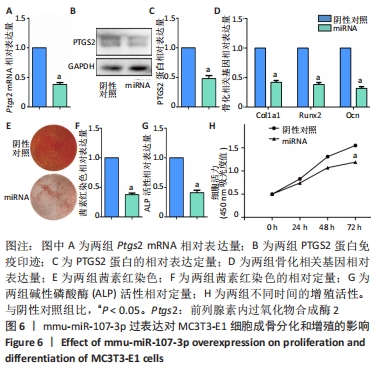
| [1] KO NY, CHEN LR, CHEN KH. The Role of Micro RNA and Long-Non-Coding RNA in Osteoporosis. Int J Mol Sci. 2020;21(14):4886. [2] KOMORI T. Runx2, an inducer of osteoblast and chondrocyte differentiation. Histochem Cell Biol. 2018;149(4):313-323. [3] WANG LJ, CAI HQ. Let-7b downgrades CCND1 to repress osteogenic proliferation and differentiation of MC3T3-E1 cells: An implication in osteoporosis. Kaohsiung J Med Sci. 2020;36(10):775-785. [4] YANG Y, YUJIAO W, FANG W, et al. The roles of miRNA, lncRNA and circRNA in the development of osteoporosis. Biol Res. 2020;53(1):40. [5] GARCIA J, DELANY AM. MicroRNAs regulating TGFβ and BMP signaling in the osteoblast lineage. Bone. 2021;143:115791. [6] ZHAI F, SONG N, MA J, et al. FGF18 inhibits MC3T3‑E1 cell osteogenic differentiation via the ERK signaling pathway. Mol Med Rep. 2017;16(4):4127-4132. [7] HUANG X, WANG X, ZHANG Y, et al. Absorption and utilisation of epimedin C and icariin from Epimedii herba, and the regulatory mechanism via the BMP2/Runx2 signalling pathway. Biomed Pharmacother. 2019;118:109345. [8] COSTA-SILVA J, DOMINGUES D, LOPES FM. RNA-Seq differential expression analysis: An extended review and a software tool. PLoS One. 2017;12(12):e0190152. [9] LI W. Volcano plots in analyzing differential expressions with mRNA microarrays. J Bioinform Comput Biol. 2012;10(6):1231003. [10] HUANG DA W, SHERMAN BT, LEMPICKI RA. Systematic and integrative analysis of large gene lists using DAVID bioinformatics resources. Nat Protoc. 2009;4(1):44-57. [11] SZKLARCZYK D, MORRIS JH, COOK H, et al. The STRING database in 2017: quality-controlled protein-protein association networks, made broadly accessible. Nucleic Acids Res. 2017;45(D1):D362-D368. [12] SHANNON P, MARKIEL A, OZIER O, et al. Cytoscape: a software environment for integrated models of biomolecular interaction networks. Genome Res. 2003; 13(11):2498-2504. [13] CHIN CH, CHEN SH, WU HH, et al. cytoHubba: identifying hub objects and sub-networks from complex interactome. BMC Syst Biol. 2014;8 Suppl 4(Suppl 4):S11. [14] AGARWAL V, BELL GW, NAM JW, et al. Predicting effective microRNA target sites in mammalian mRNAs. Elife. 2015;4:e05005. . [15] XIONG Y, CHEN L, YAN C, et al. The lncRNA Rhno1/miR-6979-5p/BMP2 Axis Modulates Osteoblast Differentiation. Int J Biol Sci. 2020;16(9):1604-1615. [16] YANG C, NILSSON L, CHEEMA MU, et al. Chitosan/siRNA nanoparticles targeting cyclooxygenase type 2 attenuate unilateral ureteral obstruction-induced kidney injury in mice. Theranostics. 2015;5(2):110-123. [17] GREGORY CA, GUNN WG, PEISTER A, et al. An Alizarin red-based assay of mineralization by adherent cells in culture: comparison with cetylpyridinium chloride extraction. Anal Biochem. 2004;329(1):77-84. [18] PISZCZEK P, RADTKE A, EHLERT M, et al. Comprehensive Evaluation of the Biological Properties of Surface-Modified Titanium Alloy Implants. J Clin Med. 2020;9(2):342. [19] ROSEN CJ. The Epidemiology and Pathogenesis of Osteoporosis//Endotext (FEINGOLD KR, ANAWALT B, BOYCE A, et al. eds). South Dartmouth (MA): MDText.com, Inc.Copyright © 2000-2021, MDText.com, Inc., 2000. [20] 白璧辉,谢兴文,李鼎鹏,等.我国近5年来骨质疏松症流行病学研究现状[J].中国骨质疏松杂志,2018,24(2):253-258. [21] 中华医学会物理医学与康复学分会,中国老年学和老年医学学会骨质疏松康复分会.原发性骨质疏松症康复干预中国专家共识[J].中华物理医学与康复杂志,2019,41(1):1-7. [22] AN J, YANG H, ZHANG Q, et al. Natural products for treatment of osteoporosis: The effects and mechanisms on promoting osteoblast-mediated bone formation. Life Sci. 2016;147:46-58. [23] KIM JM, LIN C, STAVRE Z, et al. Osteoblast-Osteoclast Communication and Bone Homeostasis. Cells. 2020;9(9):2073. [24] 中华医学会放射学分会骨关节学组,中国医师协会放射医师分会肌骨学组,中华医学会骨科学分会骨质疏松学组,等. 骨质疏松的影像学与骨密度诊断专家共识[J].中国骨质疏松杂志,2020,26(9):1249-1256. [25] ZHU S, ZHU Y, WANG Z, et al. Bioinformatics analysis and identification of circular RNAs promoting the osteogenic differentiation of human bone marrow mesenchymal stem cells on titanium treated by surface mechanical attrition.Peer J. 2020;8:e9292. [26] MAJIDINIA M, SADEGHPOUR A, YOUSEFI B. The roles of signaling pathways in bone repair and regeneration. J Cell Physiol. 2018;233(4):2937-2948. [27] EKEGREN CL, EDWARDS ER, DE STEIGER R, et al. Incidence, Costs and Predictors of Non-Union, Delayed Union and Mal-Union Following Long Bone Fracture. Int J Environ Res Public Health. 2018;15(12):2845. [28] BLACKWELL KA, RAISZ LG, PILBEAM CC. Prostaglandins in bone: bad cop, good cop?. Trends Endocrinol Metab. 2010;21(5):294-301. [29] WHEATLEY BM, NAPPO KE, CHRISTENSEN DL, et al. Effect of NSAIDs on Bone Healing Rates: A Meta-analysis. J Am Acad Orthop Surg. 2019;27(7):e330-e336. [30] GEORGE MD, BAKER JF, LEONARD CE, et al. Risk of Nonunion with Nonselective NSAIDs, COX-2 Inhibitors, and Opioids. J Bone Joint Surg Am. 2020;102(14):1230-1238. [31] LONG J, LEWIS S, KUKLO T, et al. The effect of cyclooxygenase-2 inhibitors on spinal fusion. J Bone Joint Surg Am. 2002;84(10):1763-1768. [32] GE DW, WANG WW, CHEN HT, et al. Functions of microRNAs in osteoporosis. Eur Rev Med Pharmacol Sci. 2017;21(21):4784-4789. |
| [1] | Gao Yujin, Peng Shuanglin, Ma Zhichao, Lu Shi, Cao Huayue, Wang Lang, Xiao Jingang. Osteogenic ability of adipose stem cells in diabetic osteoporosis mice [J]. Chinese Journal of Tissue Engineering Research, 2022, 26(7): 999-1004. |
| [2] | Liang Xuezhen, Yang Xi, Li Jiacheng, Luo Di, Xu Bo, Li Gang. Bushen Huoxue capsule regulates osteogenic and adipogenic differentiation of rat bone marrow mesenchymal stem cells via Hedgehog signaling pathway [J]. Chinese Journal of Tissue Engineering Research, 2022, 26(7): 1020-1026. |
| [3] | Wang Jifang, Bao Zhen, Qiao Yahong. miR-206 regulates EVI1 gene expression and cell biological behavior in stem cells of small cell lung cancer [J]. Chinese Journal of Tissue Engineering Research, 2022, 26(7): 1027-1031. |
| [4] | Zhu Bingbing, Deng Jianghua, Chen Jingjing, Mu Xiaoling. Interleukin-8 receptor enhances the migration and adhesion of umbilical cord mesenchymal stem cells to injured endothelium [J]. Chinese Journal of Tissue Engineering Research, 2022, 26(7): 1045-1050. |
| [5] | Zhang Yujie, Yang Jiandong, Cai Jun, Zhu Shoulei, Tian Yuan. Mechanism by which allicin inhibits proliferation and promotes apoptosis of rat vascular endothelial cells [J]. Chinese Journal of Tissue Engineering Research, 2022, 26(7): 1080-1084. |
| [6] | Zhang Jinglin, Leng Min, Zhu Boheng, Wang Hong. Mechanism and application of stem cell-derived exosomes in promoting diabetic wound healing [J]. Chinese Journal of Tissue Engineering Research, 2022, 26(7): 1113-1118. |
| [7] | Yang Sidi, Wang Qian, Xu Nuo, Wang Ronghan, Jin Chuanqi, Lu Ying, Dong Ming. Biodentine enhances the proliferation and differentiation of osteoblasts through upregulating bone morphogenetic protein-2 [J]. Chinese Journal of Tissue Engineering Research, 2022, 26(4): 516-520. |
| [8] | Shen Jiahua, Fu Yong. Application of graphene-based nanomaterials in stem cells [J]. Chinese Journal of Tissue Engineering Research, 2022, 26(4): 604-609. |
| [9] | Feng Dongfei, He Hongxu, Xie Qi, Zhang Lili, Zhou Hui, Li Wei. Selection of key genes related to biological functions and regulation pathway in periodontal reconstruction [J]. Chinese Journal of Tissue Engineering Research, 2022, 26(2): 253-259. |
| [10] | Cao Wei, Mao Furong, Hu Xiaohua, Yang Xiaohong. N-6 methyladenosine RNA methylation regulates osteogenic and adipogenic differentiation of bone marrow mesenchymal stem cells [J]. Chinese Journal of Tissue Engineering Research, 2022, 26(2): 266-270. |
| [11] | Wang Kun, He Benxiang. Asperosaponin VI therapy for Achilles tendinopathy in rabbits [J]. Chinese Journal of Tissue Engineering Research, 2022, 26(2): 211-217. |
| [12] | Tang Yeling, Liang Pengchen, Shi Junfeng, Sun Miaomiao, Zhou Ziyan, Zhu Lisha, Li Tian, Liang Dongyu, Sha Shuang, Yi Qingqing, Chang Qing. Exploring effective components of Guyuling capsule in the treatment of osteoporosis based on bioinformatics analysis [J]. Chinese Journal of Tissue Engineering Research, 2022, 26(12): 1899-1906. |
| [13] | Chen Cai, Zeng Ping, Liu Jinfu, Qian Xiaofen, Lu Guanyu, Xiong Bo, Chen Lihua, Huang Yue. Screening of differentially expressed genes in osteoarthritis by gene chip technique and verification using quantitative real-time PCR [J]. Chinese Journal of Tissue Engineering Research, 2022, 26(12): 1907-1914. |
| [14] | Liang Xuezhen, Xie Guoxin, Li Jiacheng, Wen Mingtao, Xu Bo, Li Gang. Identification and analysis of potential key genes in osteonecrosis of the femoral head based on miRNA-mRNA regulatory network [J]. Chinese Journal of Tissue Engineering Research, 2022, 26(11): 1720-1727. |
| [15] | Li Shibin, Xia Tian, Zhang Xiaoyun, Wang Weiwei, Zhou Yi, Lai Yu. Active monomer composition of Epimedium influences the homeostasis of bone resorption and bone formation by regulating osteoporosis related signaling pathways [J]. Chinese Journal of Tissue Engineering Research, 2022, 26(11): 1772-1779. |
| Viewed | ||||||
|
Full text |
|
|||||
|
Abstract |
|
|||||
